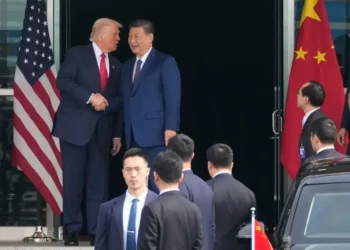U.S. Trade Gap Narrows as Tariffs Reshape Import Flows
The U.S. trade deficit contracted sharply in August after a new round of tariffs reduced the volume of imported goods. The updated data, released following a federal government shutdown, shows that President Donald Trump’s tariff program has begun shifting trade behavior even as the broader deficit for 2025 continues to rise.
The Commerce Department report, delayed for more than seven weeks, shows imports falling more quickly than exports, temporarily narrowing the monthly deficit. Economists say the August figures offer a partial view of how trade policy affected the economy in the third quarter, though the full-year trend still points toward a wider gap.
U.S. Trade Deficit Shrinks in August as Tariffs Suppress Imports, Though Annual Gap Still Expands
The U.S. trade deficit dropped by nearly a quarter in August as new tariffs imposed by the Trump administration reduced the flow of imported goods. While the monthly gap narrowed, the overall 2025 deficit remains significantly higher than last year, reflecting ongoing volatility in global trade and domestic purchasing trends. Economists say the August data, though delayed, suggests that tariffs provided a temporary lift to third-quarter economic growth.
The Trade Deficit’s Sharp August Decline
The Commerce Department reported that the U.S. trade deficit decreased to $59.6 billion in August, down from $78.2 billion in July, marking one of the steepest month-to-month drops in recent years. The decline coincided with the rollout of tariffs covering a broad range of global goods.
Imports fell 5% to $340.4 billion, a notable reversal from July, when many U.S. companies rapidly increased inventories ahead of the tariff implementation. Those levies — affecting products from nearly every major trading partner — took effect on Aug. 7.
Exports rose 0.1% to $280.8 billion, driven by marginal gains in industrial supplies and agricultural products. While the increase was slight, it helped soften the impact of declining imports.
Economists note that trade flows often react sharply to major policy shifts, especially when companies stockpile goods in advance. The large July inventory buildup amplified the appearance of an August slowdown, but analysts say tariffs clearly reduced import volumes in the short term.
A Policy Shift That Redefined U.S. Trade Strategy
The August data reflects the broader impact of President Trump’s tariffs, which have replaced decades of largely liberalized U.S. trade policy. The administration has introduced double-digit tariffs on a wide range of imports, including metals, electronics, automobiles, and raw materials such as copper and steel.
The White House argues that persistent U.S. trade deficits highlight structural imbalances and unfair foreign practices. Administration officials say the tariffs are designed to strengthen domestic manufacturing and reduce dependence on overseas supply chains.
However, trade experts and international institutions, including the World Trade Organization (WTO), have warned that such sweeping unilateral measures often disrupt supply networks, increase costs for domestic businesses, and invite retaliatory actions from trading partners.
Annual Trade Balance Still Trending Higher
Despite August’s improvement, the U.S. trade deficit for the year remains significantly elevated. Between January and August, the deficit reached $713.6 billion, up 25% from $571.1 billion during the same period in 2024.
Economists attribute the widening annual gap to strong consumer spending, resilient demand for foreign goods, and supply chain adjustments that preceded the tariffs. As companies secured inventories earlier in the year, imports rose sharply before the August decline.
Analysts say the full-year deficit trajectory is shaped not just by policy but by broader economic cycles, noting that a growing economy typically pulls in more imports.
Impact on GDP and Third-Quarter Economic Growth
A narrower trade deficit supports U.S. economic growth because imports are subtracted from gross domestic product (GDP). With August’s decline in imports, some economists expect trade to contribute positively to third-quarter GDP.
Bill Adams, chief economist at Comerica Bank, said in a commentary that the updated data “will be a tailwind for third-quarter real GDP,” suggesting that domestic spending likely shifted toward U.S.-produced goods and services.
Although the figures arrive late due to the government shutdown, analysts say they align with other indicators showing firm economic momentum during the period.
Tariff Pressures and Their Influence on Inflation
Tariffs remain at the center of a national debate over inflation. Because tariffs are paid by U.S. importers, companies often pass the additional costs on to consumers. Many economists, including researchers at the Federal Reserve and major financial institutions, say these added costs have contributed to price pressures and slowed progress toward the Fed’s 2% inflation target.
Voter concerns over high living costs played a significant role in the Nov. 4 elections, where Democrats made sizable gains in Congress. Facing mounting political pressure, President Trump announced the removal of tariffs on several household-related goods last week, including beef, coffee, tea, fruit juice, cocoa, spices, bananas, tomatoes, oranges, and certain fertilizers.
The administration acknowledged that tariffs on these items “may, in some cases” have contributed to higher consumer prices, marking a rare policy reversal.
Legal Challenges Reach the Supreme Court
The scope of the president’s tariff authority is now before the U.S. Supreme Court. A coalition of businesses and trade groups has argued that the administration overstepped its constitutional and statutory powers by imposing broad tariffs under a national emergency declaration.
During a Nov. 5 hearing, several justices expressed skepticism about the extent of executive power claimed by the administration. Legal analysts say the Court’s eventual ruling could redefine the limits of presidential authority over trade policy, a domain traditionally shared with Congress.
A decision is expected to carry major implications for future trade actions, supply chain planning, and the global business environment.
A Complex Trade Environment for 2025
The August figures illustrate the volatility of the current trade landscape as the U.S. reshapes its global economic relationships. While tariffs have temporarily reduced imports and narrowed the monthly deficit, the broader annual trend remains upward due to earlier inventory cycles and consumer demand.
Economists say the coming months will determine whether the August shift reflects a lasting pattern or a temporary reaction to policy changes. Much will depend on global market conditions, international responses, and the outcome of the Supreme Court case that could reshape U.S. trade authority for years to come.
This article was rewritten by JournosNews.com based on verified reporting from trusted sources. The content has been independently reviewed, fact-checked, and edited for accuracy, neutrality, tone, and global readability in accordance with Google News and AdSense standards.
All opinions, quotes, or statements from contributors, experts, or sourced organizations do not necessarily reflect the views of JournosNews.com. JournosNews.com maintains full editorial independence from any external funders, sponsors, or organizations.
Stay informed with JournosNews.com — your trusted source for verified global reporting and in-depth analysis. Follow us on Google News, BlueSky, and X for real-time updates.










